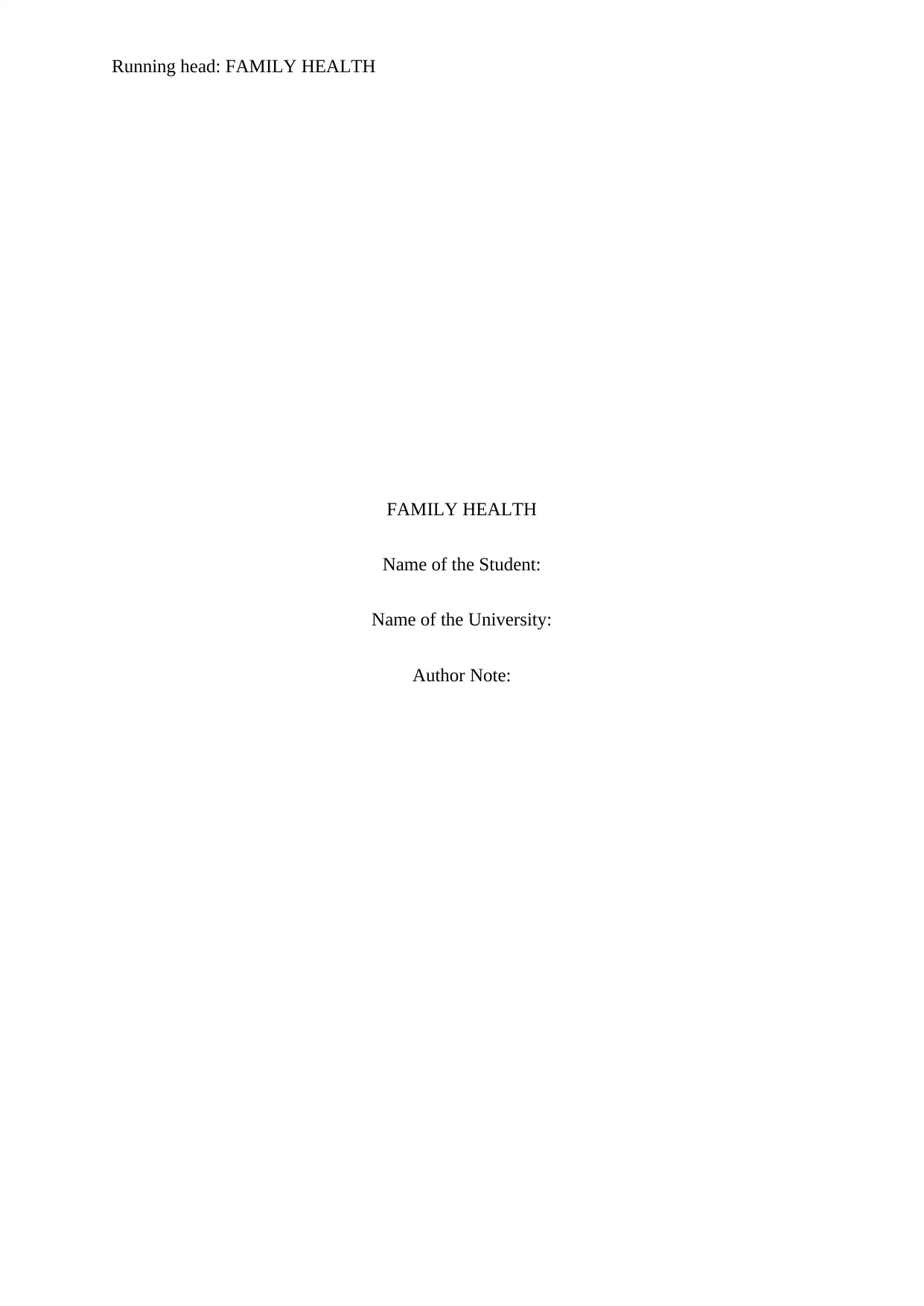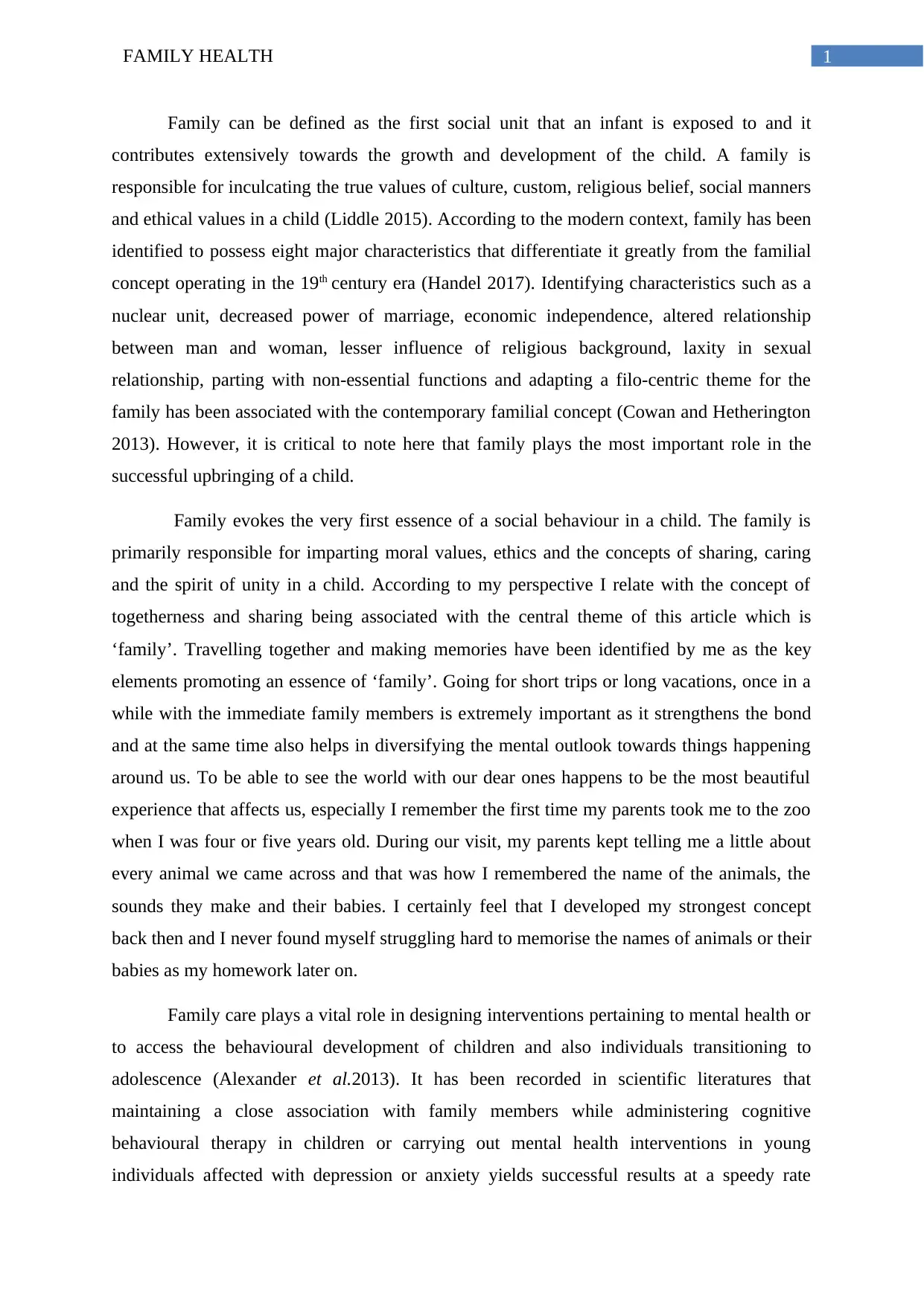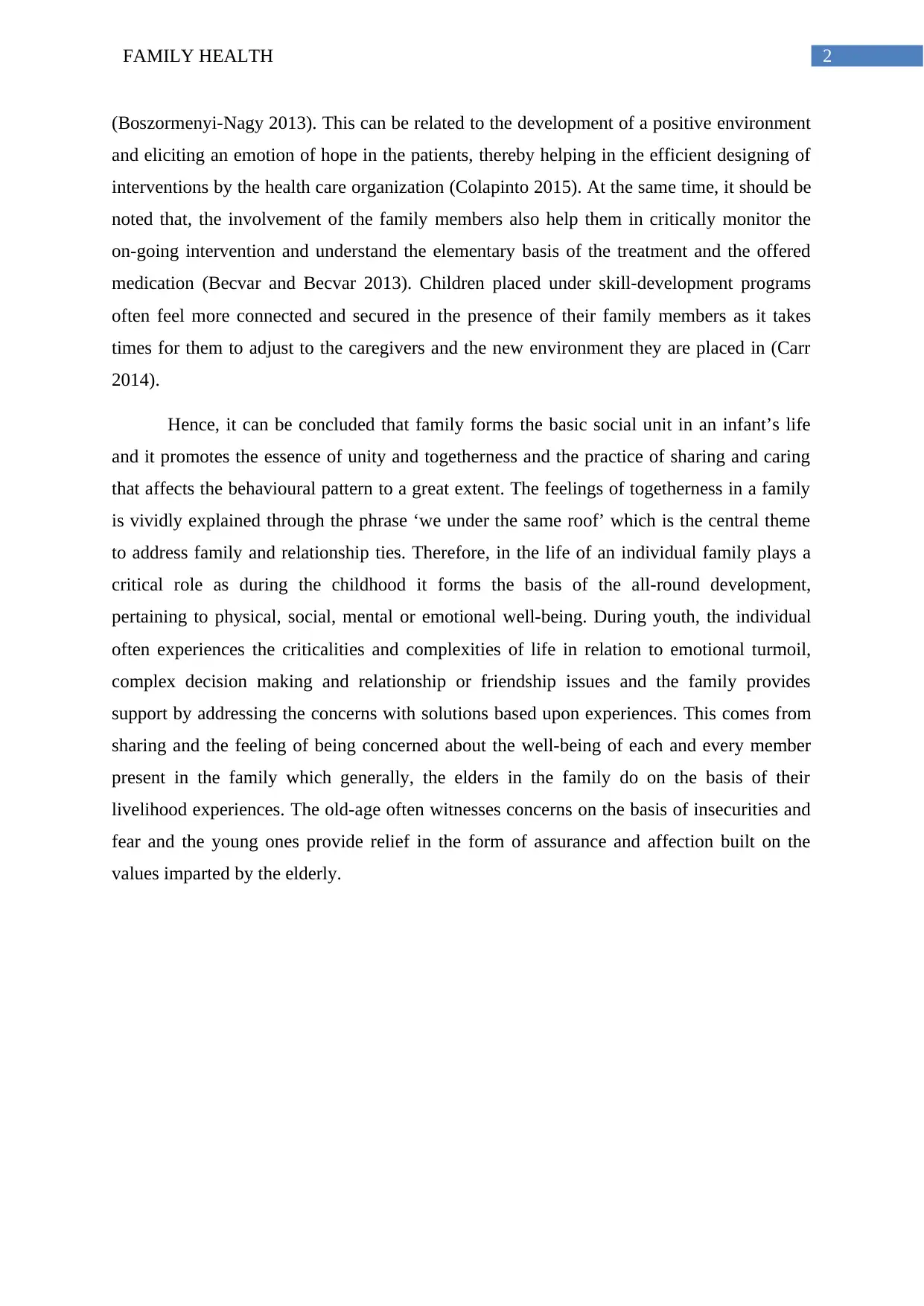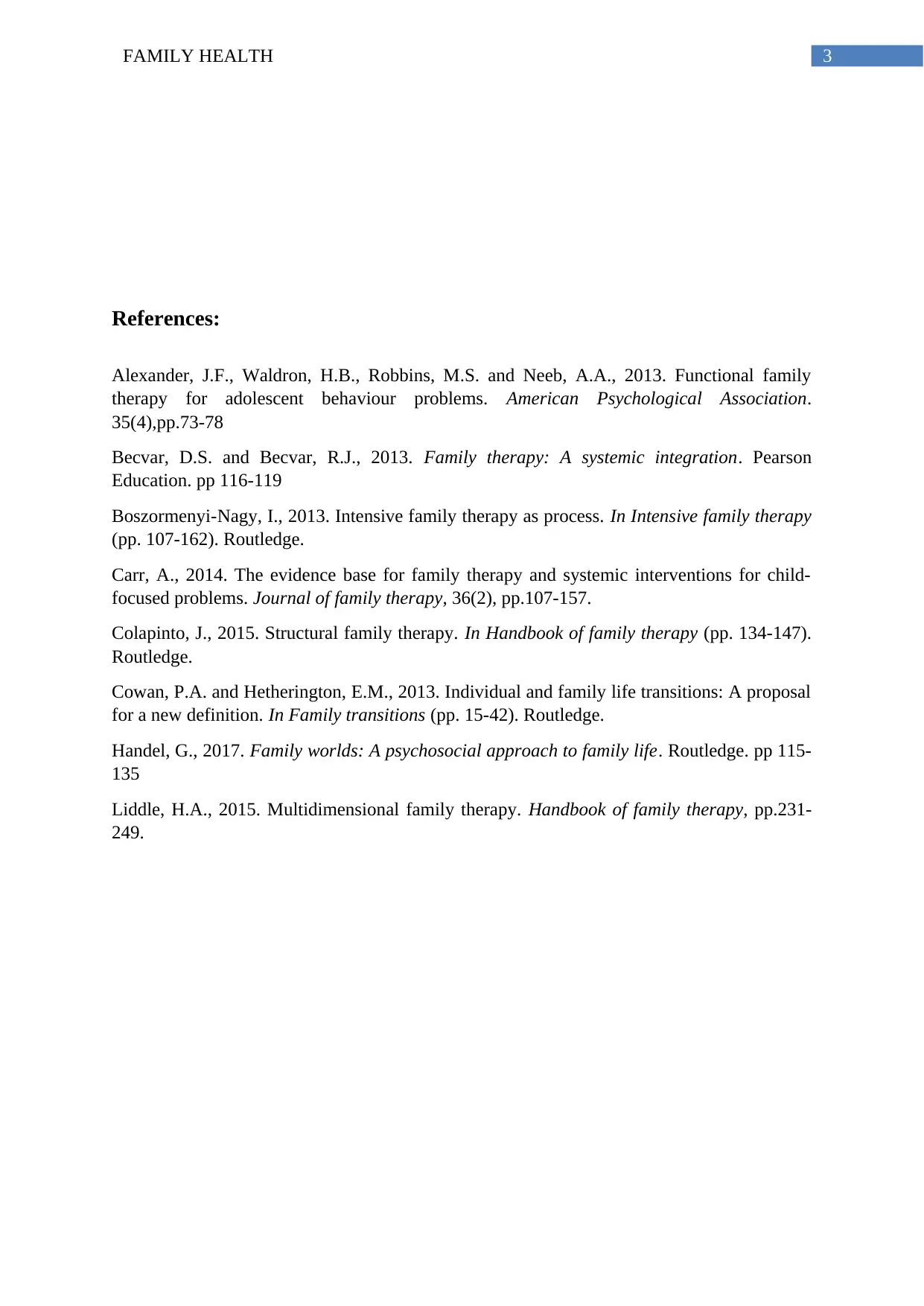Exploring Family Health: Impact on Development & Mental Well-being
VerifiedAdded on 2023/06/09
|4
|1102
|77
Essay
AI Summary
This essay delves into the profound impact of family on an individual's growth and development, emphasizing its role as the primary social unit. It highlights how families instill cultural values, ethics, and social behaviors in children, shaping their understanding of unity, sharing, and caring. The essay also explores the significance of family involvement in mental health interventions and skill-development programs, noting its positive influence on treatment outcomes and the overall well-being of individuals transitioning to adolescence. It further discusses how the feeling of togetherness in a family promotes the all-round development pertaining to physical, social, mental or emotional well-being. The essay concludes that family support is crucial throughout life, providing guidance, security, and affection during childhood, youth, and old age.

Running head: FAMILY HEALTH
FAMILY HEALTH
Name of the Student:
Name of the University:
Author Note:
FAMILY HEALTH
Name of the Student:
Name of the University:
Author Note:
Paraphrase This Document
Need a fresh take? Get an instant paraphrase of this document with our AI Paraphraser

1FAMILY HEALTH
Family can be defined as the first social unit that an infant is exposed to and it
contributes extensively towards the growth and development of the child. A family is
responsible for inculcating the true values of culture, custom, religious belief, social manners
and ethical values in a child (Liddle 2015). According to the modern context, family has been
identified to possess eight major characteristics that differentiate it greatly from the familial
concept operating in the 19th century era (Handel 2017). Identifying characteristics such as a
nuclear unit, decreased power of marriage, economic independence, altered relationship
between man and woman, lesser influence of religious background, laxity in sexual
relationship, parting with non-essential functions and adapting a filo-centric theme for the
family has been associated with the contemporary familial concept (Cowan and Hetherington
2013). However, it is critical to note here that family plays the most important role in the
successful upbringing of a child.
Family evokes the very first essence of a social behaviour in a child. The family is
primarily responsible for imparting moral values, ethics and the concepts of sharing, caring
and the spirit of unity in a child. According to my perspective I relate with the concept of
togetherness and sharing being associated with the central theme of this article which is
‘family’. Travelling together and making memories have been identified by me as the key
elements promoting an essence of ‘family’. Going for short trips or long vacations, once in a
while with the immediate family members is extremely important as it strengthens the bond
and at the same time also helps in diversifying the mental outlook towards things happening
around us. To be able to see the world with our dear ones happens to be the most beautiful
experience that affects us, especially I remember the first time my parents took me to the zoo
when I was four or five years old. During our visit, my parents kept telling me a little about
every animal we came across and that was how I remembered the name of the animals, the
sounds they make and their babies. I certainly feel that I developed my strongest concept
back then and I never found myself struggling hard to memorise the names of animals or their
babies as my homework later on.
Family care plays a vital role in designing interventions pertaining to mental health or
to access the behavioural development of children and also individuals transitioning to
adolescence (Alexander et al.2013). It has been recorded in scientific literatures that
maintaining a close association with family members while administering cognitive
behavioural therapy in children or carrying out mental health interventions in young
individuals affected with depression or anxiety yields successful results at a speedy rate
Family can be defined as the first social unit that an infant is exposed to and it
contributes extensively towards the growth and development of the child. A family is
responsible for inculcating the true values of culture, custom, religious belief, social manners
and ethical values in a child (Liddle 2015). According to the modern context, family has been
identified to possess eight major characteristics that differentiate it greatly from the familial
concept operating in the 19th century era (Handel 2017). Identifying characteristics such as a
nuclear unit, decreased power of marriage, economic independence, altered relationship
between man and woman, lesser influence of religious background, laxity in sexual
relationship, parting with non-essential functions and adapting a filo-centric theme for the
family has been associated with the contemporary familial concept (Cowan and Hetherington
2013). However, it is critical to note here that family plays the most important role in the
successful upbringing of a child.
Family evokes the very first essence of a social behaviour in a child. The family is
primarily responsible for imparting moral values, ethics and the concepts of sharing, caring
and the spirit of unity in a child. According to my perspective I relate with the concept of
togetherness and sharing being associated with the central theme of this article which is
‘family’. Travelling together and making memories have been identified by me as the key
elements promoting an essence of ‘family’. Going for short trips or long vacations, once in a
while with the immediate family members is extremely important as it strengthens the bond
and at the same time also helps in diversifying the mental outlook towards things happening
around us. To be able to see the world with our dear ones happens to be the most beautiful
experience that affects us, especially I remember the first time my parents took me to the zoo
when I was four or five years old. During our visit, my parents kept telling me a little about
every animal we came across and that was how I remembered the name of the animals, the
sounds they make and their babies. I certainly feel that I developed my strongest concept
back then and I never found myself struggling hard to memorise the names of animals or their
babies as my homework later on.
Family care plays a vital role in designing interventions pertaining to mental health or
to access the behavioural development of children and also individuals transitioning to
adolescence (Alexander et al.2013). It has been recorded in scientific literatures that
maintaining a close association with family members while administering cognitive
behavioural therapy in children or carrying out mental health interventions in young
individuals affected with depression or anxiety yields successful results at a speedy rate

2FAMILY HEALTH
(Boszormenyi-Nagy 2013). This can be related to the development of a positive environment
and eliciting an emotion of hope in the patients, thereby helping in the efficient designing of
interventions by the health care organization (Colapinto 2015). At the same time, it should be
noted that, the involvement of the family members also help them in critically monitor the
on-going intervention and understand the elementary basis of the treatment and the offered
medication (Becvar and Becvar 2013). Children placed under skill-development programs
often feel more connected and secured in the presence of their family members as it takes
times for them to adjust to the caregivers and the new environment they are placed in (Carr
2014).
Hence, it can be concluded that family forms the basic social unit in an infant’s life
and it promotes the essence of unity and togetherness and the practice of sharing and caring
that affects the behavioural pattern to a great extent. The feelings of togetherness in a family
is vividly explained through the phrase ‘we under the same roof’ which is the central theme
to address family and relationship ties. Therefore, in the life of an individual family plays a
critical role as during the childhood it forms the basis of the all-round development,
pertaining to physical, social, mental or emotional well-being. During youth, the individual
often experiences the criticalities and complexities of life in relation to emotional turmoil,
complex decision making and relationship or friendship issues and the family provides
support by addressing the concerns with solutions based upon experiences. This comes from
sharing and the feeling of being concerned about the well-being of each and every member
present in the family which generally, the elders in the family do on the basis of their
livelihood experiences. The old-age often witnesses concerns on the basis of insecurities and
fear and the young ones provide relief in the form of assurance and affection built on the
values imparted by the elderly.
(Boszormenyi-Nagy 2013). This can be related to the development of a positive environment
and eliciting an emotion of hope in the patients, thereby helping in the efficient designing of
interventions by the health care organization (Colapinto 2015). At the same time, it should be
noted that, the involvement of the family members also help them in critically monitor the
on-going intervention and understand the elementary basis of the treatment and the offered
medication (Becvar and Becvar 2013). Children placed under skill-development programs
often feel more connected and secured in the presence of their family members as it takes
times for them to adjust to the caregivers and the new environment they are placed in (Carr
2014).
Hence, it can be concluded that family forms the basic social unit in an infant’s life
and it promotes the essence of unity and togetherness and the practice of sharing and caring
that affects the behavioural pattern to a great extent. The feelings of togetherness in a family
is vividly explained through the phrase ‘we under the same roof’ which is the central theme
to address family and relationship ties. Therefore, in the life of an individual family plays a
critical role as during the childhood it forms the basis of the all-round development,
pertaining to physical, social, mental or emotional well-being. During youth, the individual
often experiences the criticalities and complexities of life in relation to emotional turmoil,
complex decision making and relationship or friendship issues and the family provides
support by addressing the concerns with solutions based upon experiences. This comes from
sharing and the feeling of being concerned about the well-being of each and every member
present in the family which generally, the elders in the family do on the basis of their
livelihood experiences. The old-age often witnesses concerns on the basis of insecurities and
fear and the young ones provide relief in the form of assurance and affection built on the
values imparted by the elderly.
⊘ This is a preview!⊘
Do you want full access?
Subscribe today to unlock all pages.

Trusted by 1+ million students worldwide

3FAMILY HEALTH
References:
Alexander, J.F., Waldron, H.B., Robbins, M.S. and Neeb, A.A., 2013. Functional family
therapy for adolescent behaviour problems. American Psychological Association.
35(4),pp.73-78
Becvar, D.S. and Becvar, R.J., 2013. Family therapy: A systemic integration. Pearson
Education. pp 116-119
Boszormenyi-Nagy, I., 2013. Intensive family therapy as process. In Intensive family therapy
(pp. 107-162). Routledge.
Carr, A., 2014. The evidence base for family therapy and systemic interventions for child‐
focused problems. Journal of family therapy, 36(2), pp.107-157.
Colapinto, J., 2015. Structural family therapy. In Handbook of family therapy (pp. 134-147).
Routledge.
Cowan, P.A. and Hetherington, E.M., 2013. Individual and family life transitions: A proposal
for a new definition. In Family transitions (pp. 15-42). Routledge.
Handel, G., 2017. Family worlds: A psychosocial approach to family life. Routledge. pp 115-
135
Liddle, H.A., 2015. Multidimensional family therapy. Handbook of family therapy, pp.231-
249.
References:
Alexander, J.F., Waldron, H.B., Robbins, M.S. and Neeb, A.A., 2013. Functional family
therapy for adolescent behaviour problems. American Psychological Association.
35(4),pp.73-78
Becvar, D.S. and Becvar, R.J., 2013. Family therapy: A systemic integration. Pearson
Education. pp 116-119
Boszormenyi-Nagy, I., 2013. Intensive family therapy as process. In Intensive family therapy
(pp. 107-162). Routledge.
Carr, A., 2014. The evidence base for family therapy and systemic interventions for child‐
focused problems. Journal of family therapy, 36(2), pp.107-157.
Colapinto, J., 2015. Structural family therapy. In Handbook of family therapy (pp. 134-147).
Routledge.
Cowan, P.A. and Hetherington, E.M., 2013. Individual and family life transitions: A proposal
for a new definition. In Family transitions (pp. 15-42). Routledge.
Handel, G., 2017. Family worlds: A psychosocial approach to family life. Routledge. pp 115-
135
Liddle, H.A., 2015. Multidimensional family therapy. Handbook of family therapy, pp.231-
249.
1 out of 4
Related Documents
Your All-in-One AI-Powered Toolkit for Academic Success.
+13062052269
info@desklib.com
Available 24*7 on WhatsApp / Email
![[object Object]](/_next/static/media/star-bottom.7253800d.svg)
Unlock your academic potential
Copyright © 2020–2025 A2Z Services. All Rights Reserved. Developed and managed by ZUCOL.





